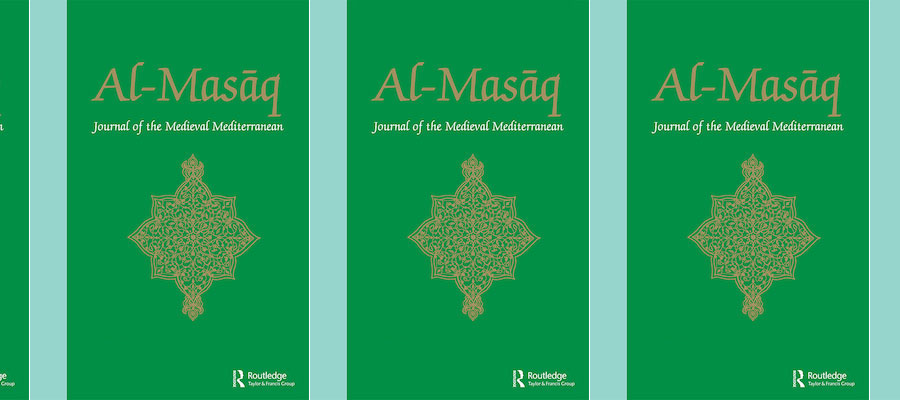Al Masaq: Islam and the Medieval Mediterranean, volume 32, number 2 (May 2020).
CONTENTS INCLUDE
Textiles in Cross-Cultural Encounters: The Case of the Umayyad Palace at Khirbat al-Mafjar
Hana Taragan
Stucco panels and paintings resembling textile carpets totally covered the walls of the Umayyad palace at Khirbat al-Mafjar (724-748) near Jericho. These carpets-like coverings, on two of which the present article will focus, present an interweaving of geometrical patterns populated by images of objects, human busts, animals, and fantastic creatures. The origin of these patterns lies in the portable textiles woven from silk, wool, and other precious materials which were brought to the Umayyad palace as gifts, goods, or booty from cultures with which Islam had contact through conquests, trade, or diplomatic relations. They represent and express cross-cultural encounters and a network of exchange between the Umayyads and China, Sassanid Iran, Sogdiana, Central Asia, Byzantium, and Coptic Egypt. I shall contend here that textiles constituted far more than simply functional objects and were rather a prime luxury item, imbued with a shared vocabulary of power and prestige.
Joseph Tarchaneiotes and the Battle of Mantzikert (AD 1071)
Antonios Vratimos
The absence of the magister Joseph Tarchaneiotes – one of the key persons involved in the events that led to the fateful battle of Mantzikert in 1071 – affected its outcome to a significant extent. This article elucidates his role in Romanos IV Diogenes’s last campaign in Asia Minor. As I demonstrate, the magister intentionally fled from the scene. Yet, his action seems to have been entirely irrelevant to the internal machinations of the Doukai. Two more issues will also be considered and precede the matter of Tarchaneiotes’s withdrawal: a) the time he was despatched to Chliat; and b) the ethnic composition of the troops under his command. Close inspection shows that his despatch from the bulk of the army took place earlier than was previously considered possible; and that his troops consisted of Armenians. In essence, our knowledge of Tarchaneiotes in medieval literature is restricted to those three issues.
An Ignored Arabic Account of a Byzantine Royal Woman
Hadi Taghavi, Ehsan Roohi, and Navid Karimi
Imperial and aristocratic Byzantine women had a wide variety of roles with a spectrum of importance. One possible way to enrich our information about Byzantine royal women is to consult the historical and cultural heritage of Byzantium’s adjacent territories. The primary aim of this article is thus to trace Byzantine women in the Arabic Shīī literature, as exemplified by the underutilised autobiography of a hitherto unidentified Roman princess named Malīka. Probably because Malīka’s autobiography, along with its hagiographic and miraculous elements, is found in a source from the Shīī adīth tradition, the account’s potential historical value has escaped the notice of previous Byzantinists. Despite its hagiographic character, Malīka’s story has a historical core. Through an intertextual study between the Arabic and Byzantine historical texts, the present study seeks to shed light on the identification of Malīka and her paternal ancestry.
